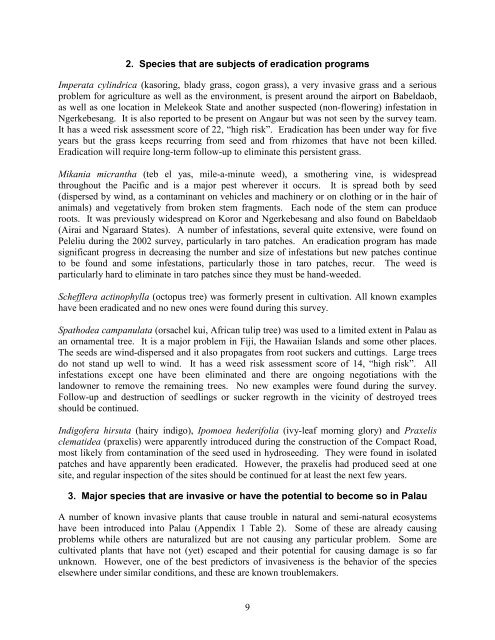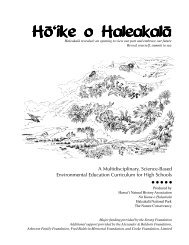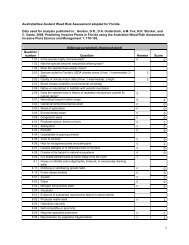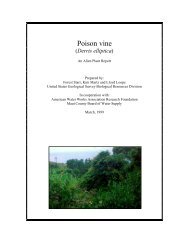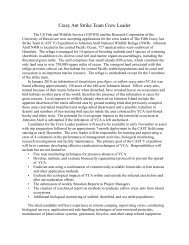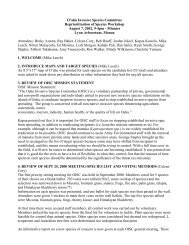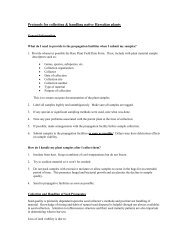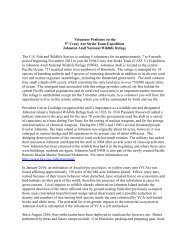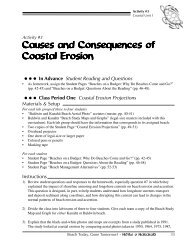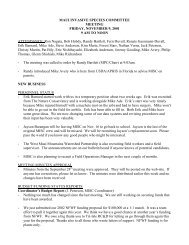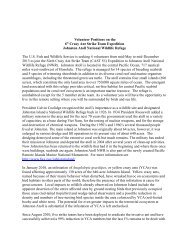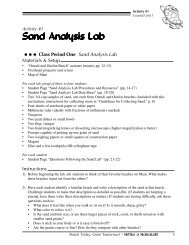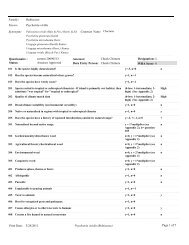Report to the Republic of Palau: 2008 update on Invasive Plant ...
Report to the Republic of Palau: 2008 update on Invasive Plant ...
Report to the Republic of Palau: 2008 update on Invasive Plant ...
Create successful ePaper yourself
Turn your PDF publications into a flip-book with our unique Google optimized e-Paper software.
2. Species that are subjects <str<strong>on</strong>g>of</str<strong>on</strong>g> eradicati<strong>on</strong> programs<br />
Imperata cylindrica (kasoring, blady grass, cog<strong>on</strong> grass), a very invasive grass and a serious<br />
problem for agriculture as well as <str<strong>on</strong>g>the</str<strong>on</strong>g> envir<strong>on</strong>ment, is present around <str<strong>on</strong>g>the</str<strong>on</strong>g> airport <strong>on</strong> Babeldaob,<br />
as well as <strong>on</strong>e locati<strong>on</strong> in Melekeok State and ano<str<strong>on</strong>g>the</str<strong>on</strong>g>r suspected (n<strong>on</strong>-flowering) infestati<strong>on</strong> in<br />
Ngerkebesang. It is also reported <str<strong>on</strong>g>to</str<strong>on</strong>g> be present <strong>on</strong> Angaur but was not seen by <str<strong>on</strong>g>the</str<strong>on</strong>g> survey team.<br />
It has a weed risk assessment score <str<strong>on</strong>g>of</str<strong>on</strong>g> 22, “high risk”. Eradicati<strong>on</strong> has been under way for five<br />
years but <str<strong>on</strong>g>the</str<strong>on</strong>g> grass keeps recurring from seed and from rhizomes that have not been killed.<br />
Eradicati<strong>on</strong> will require l<strong>on</strong>g-term follow-up <str<strong>on</strong>g>to</str<strong>on</strong>g> eliminate this persistent grass.<br />
Mikania micrantha (teb el yas, mile-a-minute weed), a smo<str<strong>on</strong>g>the</str<strong>on</strong>g>ring vine, is widespread<br />
throughout <str<strong>on</strong>g>the</str<strong>on</strong>g> Pacific and is a major pest wherever it occurs. It is spread both by seed<br />
(dispersed by wind, as a c<strong>on</strong>taminant <strong>on</strong> vehicles and machinery or <strong>on</strong> clothing or in <str<strong>on</strong>g>the</str<strong>on</strong>g> hair <str<strong>on</strong>g>of</str<strong>on</strong>g><br />
animals) and vegetatively from broken stem fragments. Each node <str<strong>on</strong>g>of</str<strong>on</strong>g> <str<strong>on</strong>g>the</str<strong>on</strong>g> stem can produce<br />
roots. It was previously widespread <strong>on</strong> Koror and Ngerkebesang and also found <strong>on</strong> Babeldaob<br />
(Airai and Ngaraard States). A number <str<strong>on</strong>g>of</str<strong>on</strong>g> infestati<strong>on</strong>s, several quite extensive, were found <strong>on</strong><br />
Peleliu during <str<strong>on</strong>g>the</str<strong>on</strong>g> 2002 survey, particularly in taro patches. An eradicati<strong>on</strong> program has made<br />
significant progress in decreasing <str<strong>on</strong>g>the</str<strong>on</strong>g> number and size <str<strong>on</strong>g>of</str<strong>on</strong>g> infestati<strong>on</strong>s but new patches c<strong>on</strong>tinue<br />
<str<strong>on</strong>g>to</str<strong>on</strong>g> be found and some infestati<strong>on</strong>s, particularly those in taro patches, recur. The weed is<br />
particularly hard <str<strong>on</strong>g>to</str<strong>on</strong>g> eliminate in taro patches since <str<strong>on</strong>g>the</str<strong>on</strong>g>y must be hand-weeded.<br />
Schefflera actinophylla (oc<str<strong>on</strong>g>to</str<strong>on</strong>g>pus tree) was formerly present in cultivati<strong>on</strong>. All known examples<br />
have been eradicated and no new <strong>on</strong>es were found during this survey.<br />
Spathodea campanulata (orsachel kui, African tulip tree) was used <str<strong>on</strong>g>to</str<strong>on</strong>g> a limited extent in <str<strong>on</strong>g>Palau</str<strong>on</strong>g> as<br />
an ornamental tree. It is a major problem in Fiji, <str<strong>on</strong>g>the</str<strong>on</strong>g> Hawaiian Islands and some o<str<strong>on</strong>g>the</str<strong>on</strong>g>r places.<br />
The seeds are wind-dispersed and it also propagates from root suckers and cuttings. Large trees<br />
do not stand up well <str<strong>on</strong>g>to</str<strong>on</strong>g> wind. It has a weed risk assessment score <str<strong>on</strong>g>of</str<strong>on</strong>g> 14, “high risk”. All<br />
infestati<strong>on</strong>s except <strong>on</strong>e have been eliminated and <str<strong>on</strong>g>the</str<strong>on</strong>g>re are <strong>on</strong>going negotiati<strong>on</strong>s with <str<strong>on</strong>g>the</str<strong>on</strong>g><br />
landowner <str<strong>on</strong>g>to</str<strong>on</strong>g> remove <str<strong>on</strong>g>the</str<strong>on</strong>g> remaining trees. No new examples were found during <str<strong>on</strong>g>the</str<strong>on</strong>g> survey.<br />
Follow-up and destructi<strong>on</strong> <str<strong>on</strong>g>of</str<strong>on</strong>g> seedlings or sucker regrowth in <str<strong>on</strong>g>the</str<strong>on</strong>g> vicinity <str<strong>on</strong>g>of</str<strong>on</strong>g> destroyed trees<br />
should be c<strong>on</strong>tinued.<br />
Indig<str<strong>on</strong>g>of</str<strong>on</strong>g>era hirsuta (hairy indigo), Ipomoea hederifolia (ivy-leaf morning glory) and Praxelis<br />
clematidea (praxelis) were apparently introduced during <str<strong>on</strong>g>the</str<strong>on</strong>g> c<strong>on</strong>structi<strong>on</strong> <str<strong>on</strong>g>of</str<strong>on</strong>g> <str<strong>on</strong>g>the</str<strong>on</strong>g> Compact Road,<br />
most likely from c<strong>on</strong>taminati<strong>on</strong> <str<strong>on</strong>g>of</str<strong>on</strong>g> <str<strong>on</strong>g>the</str<strong>on</strong>g> seed used in hydroseeding. They were found in isolated<br />
patches and have apparently been eradicated. However, <str<strong>on</strong>g>the</str<strong>on</strong>g> praxelis had produced seed at <strong>on</strong>e<br />
site, and regular inspecti<strong>on</strong> <str<strong>on</strong>g>of</str<strong>on</strong>g> <str<strong>on</strong>g>the</str<strong>on</strong>g> sites should be c<strong>on</strong>tinued for at least <str<strong>on</strong>g>the</str<strong>on</strong>g> next few years.<br />
3. Major species that are invasive or have <str<strong>on</strong>g>the</str<strong>on</strong>g> potential <str<strong>on</strong>g>to</str<strong>on</strong>g> become so in <str<strong>on</strong>g>Palau</str<strong>on</strong>g><br />
A number <str<strong>on</strong>g>of</str<strong>on</strong>g> known invasive plants that cause trouble in natural and semi-natural ecosystems<br />
have been introduced in<str<strong>on</strong>g>to</str<strong>on</strong>g> <str<strong>on</strong>g>Palau</str<strong>on</strong>g> (Appendix 1 Table 2). Some <str<strong>on</strong>g>of</str<strong>on</strong>g> <str<strong>on</strong>g>the</str<strong>on</strong>g>se are already causing<br />
problems while o<str<strong>on</strong>g>the</str<strong>on</strong>g>rs are naturalized but are not causing any particular problem. Some are<br />
cultivated plants that have not (yet) escaped and <str<strong>on</strong>g>the</str<strong>on</strong>g>ir potential for causing damage is so far<br />
unknown. However, <strong>on</strong>e <str<strong>on</strong>g>of</str<strong>on</strong>g> <str<strong>on</strong>g>the</str<strong>on</strong>g> best predic<str<strong>on</strong>g>to</str<strong>on</strong>g>rs <str<strong>on</strong>g>of</str<strong>on</strong>g> invasiveness is <str<strong>on</strong>g>the</str<strong>on</strong>g> behavior <str<strong>on</strong>g>of</str<strong>on</strong>g> <str<strong>on</strong>g>the</str<strong>on</strong>g> species<br />
elsewhere under similar c<strong>on</strong>diti<strong>on</strong>s, and <str<strong>on</strong>g>the</str<strong>on</strong>g>se are known troublemakers.<br />
9


